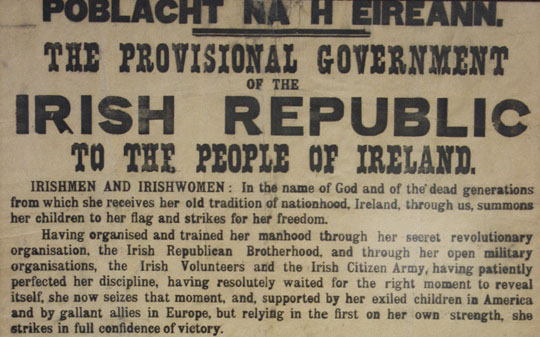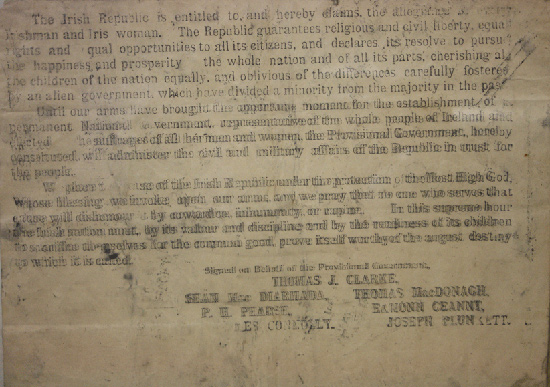1916
Printing Press Shooter – Printing the Proclamation of Independence
This small brass ‘shooter’ was used to lock the type on the press used to print the Proclamation of Independence. It is inscribed “C Brady”, one of the printers.
By Brenda Malone
Who created the Proclamation of Independence?
This document was the joint product of the leadership of the Irish Volunteers, the Irish Citizen Army and the Irish Republican Brotherhood (the Military Council), though it is generally considered that its literary composition is that of Patrick Pearse, with amendments by James Connolly. It was composed in Liberty Hall, the headquarters of the Irish Transport and General Workers Union and the location of the Military Council’s meetings to plan the Rising.

Where was the Proclamation printed?
Liberty Hall was also the location of the printing press, an antiquated Wharfdale Double Crown, used to print The Worker’s Republic newspaper. It was on this press that the Proclamation was printed on the Sunday 23rd April by printer Christopher Brady and compositors Liam O’Brien and Michael Molloy.
On receiving the text of the document, the printers began setting up the type, the shooter being used to lock the type into position. They soon found that there was insufficient type for the job and eventually concluded that they would have to print the document in two halves. The compositors set the type for the first half and printed about 2,500 copies. They then re-set the forme to print the second part on the bottom half of the same sheets.
The ‘Half Proclamation’
The ‘half proclamation’ was printed by British soldiers about April 29 - May 6, 1916, as they occupied the building after the surrender. They found the machine set up to print the bottom part of the Proclamation and printed a number of posters as souvenirs.

How did the Museum acquire the shooter?
The shooter was given to the National Museum of Ireland by the printer Christopher Brady in April 1935 for display in a new exhibition. This was also the first year the Museum began to officially collect objects relating to historic events.
1935 saw the opening of a permanent exhibition at the Museum called Relics of the Struggle for Independence. It exhibited about 500 objects ranging in date from the Rising to the close of the Civil War. Included were a copy of the Proclamation verified by the printers Brady, Molloy and O’Brien, weapons from the Howth gun-running, last letters of the executed leaders, Pearse’s Mauser pistol, relics of the Mountjoy executions in 1920 and 1921, and the boots worn by Harry Boland when, travelling as a stoker on a ship, he smuggled official Dáil Éireann documents to America.
The 1932 Exhibition – Nellie Gifford-Donnelly and the 1916 Club
The 1935 exhibition was not the first on the struggle for Irish Independence to be held at the Museum. Helen Ruth, or “Nellie”, Gifford-Donnelly, through her work with the 1916 Club, was the prime force behind both the first 1916 exhibition and the building of the Easter Week Collection, as it became known. A committed nationalist and feminist, she was one of the well-known Gifford sisters, and the only one to participate in the Rising.
In 1932 she was the secretary of the 1916 Club, and began corresponding with the Department of Education to propose an exhibition on the fight for Irish Independence to coincide with the 31st International Eucharistic Congress to be held in Dublin that year. She requested that the Museum host the exhibition and, despite some concerns from the Museum about space and finance, a small space was agreed and Nellie set about sourcing objects for display.
Due to her involvement in the 20th century nationalist movement and her personal connections with other participants, Nellie was ideally positioned to collect artefacts with a strong provenance relating to the Rising and the following years. Christopher Brady first gave the brass shooter from the printing press from Liberty Hall to her for display in 1932, later giving it to the Museum in 1935 when it was guaranteed a permanent home.
The Easter Week Collection remained with the National Museum of Ireland and continued to grow there, though Nellie was not to work on the collection after the first exhibition was dismantled in 1933. She can be seen as the first curator of the Museum’s 1916 exhibition, and we are indebted to her for starting the collection which documents the events of the years leading to independence.
Learn More
An original copy of the Proclamation of Independence, along with a half proclamation and examples of the type used in the printing are on permanent display in the Understanding 1916 exhibition at Collins Barracks.
Further Reading
- Unlikely Rebels, The Gifford Girls and the Fight For Irish Freedom, by Anne Clare. Mercier Press, 2011
- The Republican Proclamation of Easter Monday, 1916, by Joseph J. Bouche. The Bibliographical Society of Ireland, Volume 4, No. 3. Published by The Sign of the Three Candles, Dublin, 1936.
- The 1916 Proclamation, by John O’Connor. Anvil Books, 1986.
Location:
Printing Press Shooter – Printing the Proclamation of Independence is located at:
In Storage
Previous artefact:
Next artefact:
